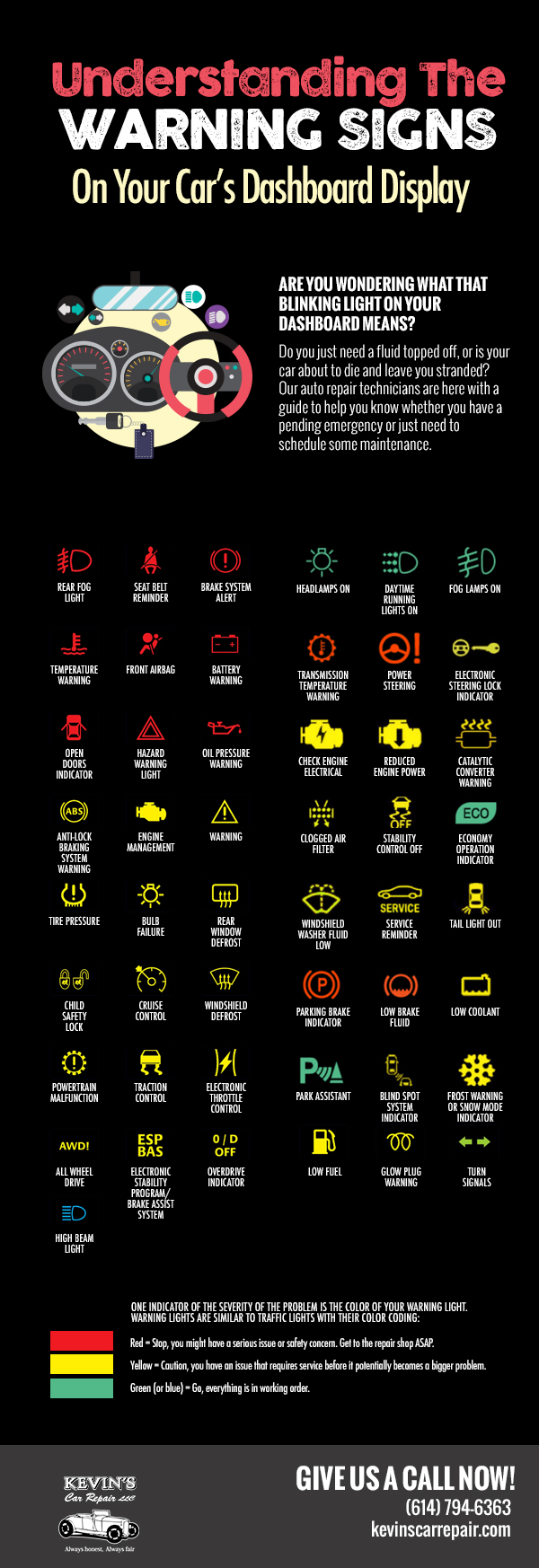Translating Your Auto'S Alert Lighting: Their True Effects
Translating Your Auto'S Alert Lighting: Their True Effects
Blog Article
Web Content Create By-Faulkner Torres
When you're behind the wheel, those radiant caution lights on your control panel can be a bit complicated. Do you understand what they're attempting to tell you about your cars and truck's wellness? Comprehending the value of these lights is vital for your security and the longevity of your automobile. So, the next time one of those lights turns up, wouldn't you intend to analyze its message properly and take the needed steps to address it?
Common Caution Lighting and Interpretations
Recognize typical caution lights in your automobile and understand their significances to ensure risk-free driving.
One of the most normal warning lights consist of the check engine light, which signifies concerns with the engine or discharges system. If this light begins, it's essential to have your lorry examined quickly.
The oil stress warning light indicates low oil stress, needing instant attention to avoid engine damage.
A flashing battery light might recommend a malfunctioning billing system, possibly leaving you stranded otherwise dealt with.
The tire stress monitoring system (TPMS) light alerts you to reduced tire pressure, affecting lorry stability and fuel performance. Neglecting this might result in unsafe driving problems.
The ABS light indicates a trouble with the anti-lock braking system, compromising your ability to stop swiftly in emergencies.
Last but not least, the coolant temperature alerting light warns of engine getting too hot, which can result in serious damages otherwise dealt with quickly.
Understanding these usual caution lights will aid you deal with problems immediately and maintain risk-free driving problems.
Relevance of Prompt Focus
Understanding the usual caution lights in your car is only the initial step; the relevance of quickly resolving these cautions can't be stressed enough to guarantee your safety and security when driving.
When https://brakefluidprice06284.bleepblogs.com/32623423/exactly-how-can-mobile-automobile-outlining-change-your-vehicle-treatment-experience-while-ensuring-top-quality-discover-the-vital-variables-to-think-about-prior-to-selecting-a-detailer brightens on your control panel, it's your auto's means of interacting a prospective issue that requires interest. Disregarding these warnings can result in more extreme problems in the future, endangering your safety and security and possibly costing you more out of commission.
Trigger attention to cautioning lights can avoid break downs and mishaps. For example, a blinking check engine light could indicate a misfire that, if left neglected, could trigger damages to the catalytic converter. Resolving this quickly can save you from a pricey repair service.
Similarly, a brake system cautioning light could indicate low brake liquid or worn brake pads, essential elements for your security when driving.
Do It Yourself Troubleshooting Tips
If you notice a warning light on your dashboard, there are a few do it yourself fixing tips you can attempt before looking for specialist assistance.
https://www.blackstarnews.com/ny-watch/business/woman-owned-auto-repair-shop-specializes-services-for-women.html is to consult your car's handbook to comprehend what the certain warning light suggests. Often the issue can be as easy as a loosened gas cap causing the check engine light. Tightening the gas cap may fix the trouble.
Another common problem is a reduced battery, which can trigger various alerting lights. Checking the battery links for rust and guaranteeing they're safe and secure might repair the problem.
If a caution light continues, you can attempt resetting it by separating the automobile's battery for a few minutes and afterwards reconnecting it. Furthermore, inspecting your automobile's fluid degrees, such as oil, coolant, and brake fluid, can aid fix cautioning lights related to these systems.
Conclusion
Finally, understanding your automobile's caution lights is vital for maintaining your lorry running smoothly and safely. By immediately addressing these alerts and understanding what they mean, you can prevent costly repairs and prospective malfunctions.
Bear in mind to consult your vehicle's manual for certain information on each cautioning light and take action as necessary to make certain a hassle-free driving experience.
Stay informed, remain risk-free on the road!
